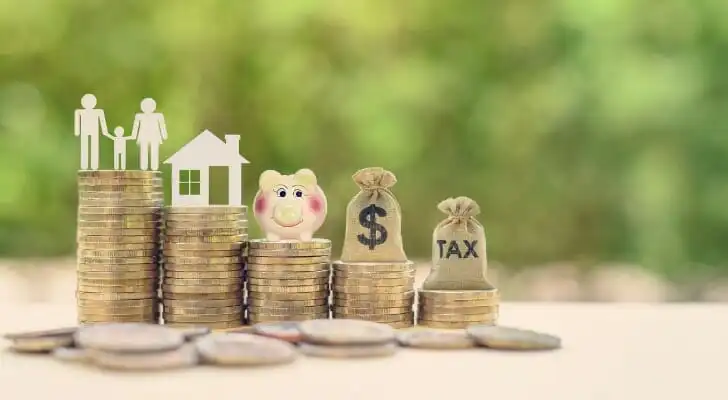Investments build wealth but taxes on capital gains can take a big bite out of your earnings. Following a buy, borrow, die strategy is one way to minimize your tax liability and preserve more of your wealth. Developed by Professor Edward J. McCaffery in the 1990s, “buy, borrow, die” explains how people get rich and stay that way. Nearly 30 years later, the term has resurfaced amid discussions of tax inequality and what regular people can do to reduce their tax burden.
A financial advisor can help you develop an investment and tax strategy that meets your long-term goals.
What Is Buy, Borrow, Die?
Buy, borrow, die is a concept that attempts to explain how wealthier people can hold on to their wealth by minimizing what they pay in taxes. The theory holds that rich people aren’t gaming the tax system with loopholes or fraudulent practices. Instead, they’re limiting what they have to pay in taxes through strategic investing and planning.
It’s called buy, borrow, die because those are the three components of how the strategy works. McCaffery developed the concept to help explain how rich people avoid taxes compared to the average American.
How Does a Buy, Borrow, Die Strategy Work?
Buy, borrow, die is a pretty straightforward strategy once you understand what each of the three steps stands for. Let’s take a look at each piece of the strategy to better understand what happens along the way.
Step 1: Buy
The “buy” part is what it sounds like. You use part of your wealth to purchase appreciating assets. Appreciating assets include things like:
- Stocks
- Real estate
- Artwork
- Fine wine
- Other Collectibles
The goal is to capitalize on the increase in value those assets will realize over time. Real estate, for example, tends to go up in value year over year, unlike vehicles and other forms of real property. Owning property can also be a way to hedge against rising inflation or increased volatility in the stock market.
Moreover, buying real estate can lead to tax breaks if you’re able to write off the depreciation. You can also generate income if you own a rental property that you lease out seasonally or on a full-time basis.
Ideally, you buy assets that will grow in value on a tax-deferred basis and yield passive income. Passive income is money that you don’t have to work to earn. Dividends earned from stocks, for example, are another form of passive income.
Part 2: Borrow
Once you’ve bought appreciating assets, the next step is to borrow against them. In other words, you use those assets as collateral for loans.
Why would you do that? According to the buy, borrow, die strategy, leveraging assets as collateral allows you to borrow money while preserving the value of the underlying assets. Rather than selling off investments for cash and incurring capital gains tax, you can borrow against your assets instead.
There’s a double tax benefit here since you’re not on the hook for capital gains tax and the loan proceeds aren’t counted as taxable income.
Of course, it’s important to use the right assets as leverage for a loan. Again, that’s where owning real estate can come in handy, as you can use it as collateral to secure loans. Taking out a loan from your retirement account, on the other hand, can drain your wealth and potentially result in a tax hit.
When you take out a 401(k) loan, for example, you’re borrowing from yourself, but any money you take out isn’t growing on a tax-deferred basis. That can shortchange your wealth-building strategy in the long run. There’s an added risk in that if you’re unable to pay the loan, the IRS treats the entire amount as a taxable distribution.
Part 3: Die
Thinking about death isn’t pleasant, but wealthy people understand the importance of estate planning and what happens to assets when you pass away. Minimizing estate tax is often a top priority, as doing so can help you to leave behind more of your wealth for your loved ones.
In a buy, borrow, die strategy, the individuals who inherit your estate can use some of the assets you’ve passed on to pay off outstanding loans. That allows them to avoid having to settle those debts out of their own pockets.
Additionally, your heirs benefit from a step-up in the cost basis of those assets once they receive them. That step-up allows them to avoid any capital gains tax due on the sale of assets they inherit. The other option is for them to hold on to the assets and not sell them. Should they decide to go that route, they can continue implementing a buy, borrow, die strategy for themselves and the next generation of heirs.
Does Buy, Borrow, Die Really Work?

A buy, borrow, die strategy can be an effective way to minimize taxation for people who can follow it. Buying appreciating assets allows you to benefit from their long-term growth in value while potentially enjoying some current income. You can then use those assets to secure loans that are not taxable income.
The main flaw with the buy, borrow, die approach is that it requires a certain amount of money to take advantage of it. Someone whose net worth is in the four- or five-figure range, for instance, may not have sufficient means to buy appreciating assets. That may not be an issue for someone with a net worth of $1 million or more.
In other words, it takes wealth to create wealth using a buy, borrow, die strategy, which isn’t realistic for most people. If you own a home, you might already have an appreciating asset to start with. But your only options for borrowing against it may be limited to a home equity loan or line of credit.
Using a home equity loan or HELOC to access cash can be problematic if you’re not able to keep up with the payments. Should you default on the loan, the lender could initiate a foreclosure proceeding against you. In the worst-case scenario, you could end up losing your one appreciating asset.
Where Did Buy, Borrow, Die Come From?
Ed McCaffery, a law professor at the University of Southern California, came up with this tax-avoidance strategy in the mid-1990s to help students grasp how the rich avoid taxes.
He noted that there are two things the government does not tax: unsold assets, even if they have appreciated, and debt. And since debt is not taxed, it makes sense to avoid capital gains taxes on assets that have appreciated by borrowing against them. Then, when the owner dies, these assets can be sold tax-free by beneficiaries of the owner’s estate.
McCaffery explained the process in “Fair Not Flat: How to Make the Tax System Better and Simpler,” which was published in 2002.
Other Tips for Avoiding Taxes With Your Investment Portfolio
Managing your investments with tax efficiency in mind can significantly boost your long-term returns. Here are key strategies to minimize the tax burden on your investment portfolio:
- Maximize tax-advantaged accounts: Accounts like 401(k)s, IRAs and HSAs offer powerful tax benefits that can shelter your investments from immediate taxation. Contributing to these accounts allows your investments to grow tax-deferred or even tax-free in the case of Roth accounts, potentially saving you thousands over your investing lifetime.
- Consider tax-loss harvesting: This strategy involves selling investments that have declined in value to offset capital gains elsewhere in your portfolio. By strategically realizing losses, you can reduce your overall tax liability while maintaining your desired asset allocation through similar but not identical investments.
- Hold investments longer than one year: Long-term capital gains (from assets held more than 12 months) are taxed at lower rates than short-term gains. Depending on your income bracket, you might pay 0%, 15%, or 20% on long-term gains versus your ordinary income tax rate on short-term gains.
- Invest in tax-efficient funds: Index funds and ETFs typically generate fewer taxable events than actively managed funds. These investment vehicles generally have lower turnover rates, resulting in fewer capital gains distributions and a smaller tax bill for investors holding them in taxable accounts.
- Consider municipal bonds for taxable accounts: Interest from municipal bonds is typically exempt from federal taxes and often state taxes if you live in the issuing state. This tax advantage can make buying municipal bonds particularly attractive for high-income investors, despite their generally lower yields compared to taxable bonds.
Implementing these tips for avoiding taxes with your investment portfolio requires thoughtful planning and sometimes professional guidance, but the long-term benefits to your wealth can be substantial.
Risks and Limitations of the Buy, Borrow, Die Strategy
A buy, borrow, die strategy is often described in simple terms, but it carries several risks that can affect long-term financial health. Borrowing against appreciating assets may provide access to cash without triggering taxable gains, but it also creates debt that must be repaid. Large personal loans secured by investments or real estate can become difficult to maintain if values fall or interest rates rise. If the underlying assets lose value, a lender may require additional collateral or repayment.
The strategy also depends heavily on estate planning rules that allow heirs to receive a step-up in cost basis. Changes to tax laws could limit or eliminate this benefit in the future. If that happens, heirs could face unexpected tax liabilities on inherited assets that were intended to be passed on tax-efficiently. Wealthy individuals may be able to adjust to these changes, but most households would face challenges if tax rules shift.
Lenders do not treat all borrowers the same. Accessing large credit lines against investments or real estate generally requires high income, strong credit, and substantial assets. Many investors may not qualify for these types of loans, or they may only qualify at higher interest rates that reduce the benefit of avoiding capital gains tax.
Borrowing against assets can also reduce financial flexibility. Payments must continue even during market downturns or personal financial setbacks. Missing payments on loans backed by real estate can lead to foreclosure. Missing payments on loans backed by investment portfolios can result in liquidations or margin calls.
Because the strategy relies on maintaining and passing on significant assets, buy, borrow, die is not realistic for many investors. It also does not replace the need for a diversified financial plan. Even high-net-worth households may benefit from tax-advantaged retirement accounts, insurance, and traditional savings strategies that reduce risk.
Bottom Line

Buy, borrow, die is a legitimate way to minimize what you pay in taxes as you work on building wealth. Implementing this strategy can be difficult, however, if you don’t have a lot of financial resources on tap yet. In the meantime, you can work on increasing wealth through more traditional means. For example, maxing out your 401(k) or opening an individual retirement account (IRA) can be an excellent way to begin creating wealth on a tax-advantaged basis.
Estate Planning Tips
- Consider talking with your financial advisor about how you might be able to include buy, borrow, die into your financial plan. Your advisor may also be able to offer other ideas on ways to minimize your tax burden through tax-efficient investments. Finding a financial advisor doesn’t have to be hard. SmartAsset’s free tool matches you with vetted financial advisors who serve your area, and you can have a free introductory call with your advisor matches to decide which one you feel is right for you. If you’re ready to find an advisor who can help you achieve your financial goals, get started now.
- Tax planning is just one consideration when creating an estate plan. It’s also important to think about how your assets will be passed on to your heirs. Creating a will is a basic step in estate planning, but you may also want to explore the benefits of establishing a trust. Other elements to consider include life insurance needs and the creation of additional streams of income. An annuity, for instance, can provide you with a consistent source of income in retirement so that you don’t have to spend down other assets.
Photo credit: ©iStock.com/courtneyk, ©iStock.com/Matt Gush, ©iStock.com/William_Potter
